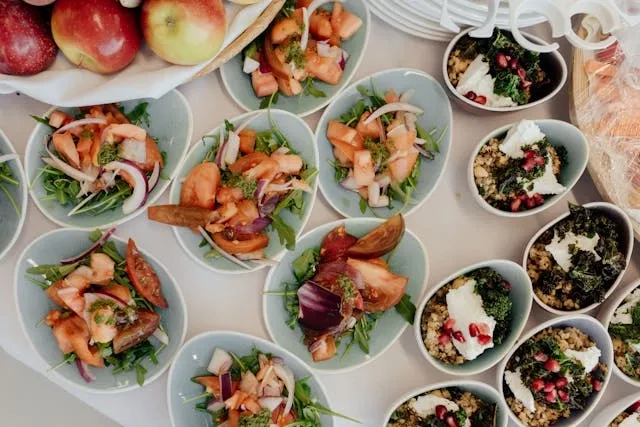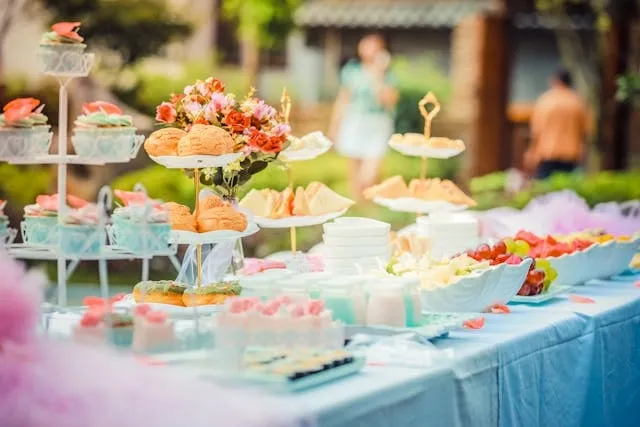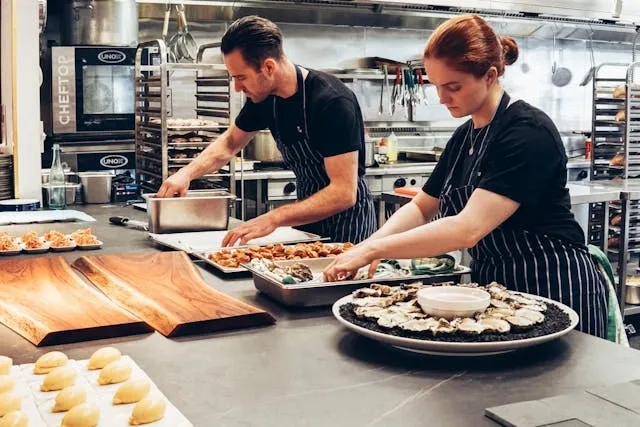Catering Equipment Checklist For Events: Setup Guide For Success
To plan an event, there are many details to consider, but ensuring you have the right catering equipment is crucial. Our comprehensive catering supplies checklist will guide you through essential items that you need for a seamless event setup. From serving trays to warming stations, this guide is intended to help you keep everything running smoothly on your big day.

Key Takeaways
- A catering checklist should cover menu planning, equipment, supplies, and staffing to ensure all aspects of the catering journey are accounted for.
- When you prepare a comprehensive catering checklist for events, you can prevent last-minute scrambles and ensure a seamless catering process.
- Tailor your checklist to your specific event type, ensuring the needs are met and you deliver a well-organized event for your guests.
- We supply high-quality custom table covers for events of all types to help create the right ambiance and provide an essential practical tool for serving food to your guests.
Table of contents
-
Catering Checklist
-
How To Create A Catering Checklist?
-
What Should A Catering Checklist Absolutely Include For Events?
-
What Is A Catering Equipment Checklist?
-
How To Plan For Catering Supplies And Equipment
-
What Is The Checklist For Buffet Catering Setup?
-
How Do You Organize A Catering Event In General?
-
What Are The Guidelines For A Successful Catering Event?
-
How Do You Calculate Food Quantities For Catering?
-
What All Caterers Must Have
-
Should You Rent Or Buy Catering Equipment?
-
How Do You Communicate With Catering Services?
-
How To Write A Catering Proposal?
-
What Is The Importance Of Catering In Modern Society?
Catering Checklist
A catering checklist is a detailed guide that outlines the equipment, supplies, and tasks that you need to have in mind for a successful event. The primary purpose is to ensure that every aspect of catering is accounted for, whether it’s garnishes, scheduling, or the custom printed tablecloths.
By approaching it in a structured way, a checklist aids your organization and time management to ensure nothing is missed. Key benefits include:
- Preventing last-minute scrambles for essential items
- An efficient, seamless catering process
- Enhanced overall presentation
With a detailed catering event planning checklist, you can streamline your catering process for a smooth and memorable guest experience. Work with us to create the appropriate tablecloths or runners with an affordable custom service to meet this need.

How To Create A Catering Checklist?
Creating your catering equipment checklist starts with understanding details like your event type and size. Define the scope from the outset - is it a wedding, corporate event, or barbecue? Once this is established, outline the essential elements:
- Menu planning: List the proposed dishes, including starters, main courses, sides, and desserts.
- Equipment: Identify what you will need, such as chafing dishes, serving trays, and warming stations.
- Supplies: Include cutlery, glassware, and napkins, and identify the best table covers for events.
Tailor your checklist to the specifics of your event. Weddings need an elegant presentation with cohesive decor. Barbecues need outdoor equipment and casual dining supplies. By creating a checklist specific to your event, you leave no stone unturned, so you can achieve a well-organized, successful event.
Make sure you get the right tablecloths for your event
When you design custom event tablecloths with us, you can get the right table cover for your needs, choosing the size, fit, colors, and bespoke design elements.
What Should A Catering Checklist Absolutely Include For Events?
The latest statistics suggest that the top decision influencers for customers ordering catering services are quality and taste, and order accuracy. With that in mind, your catering checklist must include:
- Menu planning and ingredients: Finalize the menu with a detailed list of dishes and required ingredients. Ensure every item is accounted for, including dietary restrictions and special requests.
- Logistics and timelines: Coordinate your delivery times, setup procedures, and service schedules. You should arrange when equipment and food will arrive and how long the setup will take. The food service should align with event activities.
- Staffing: Plan the required personnel like chefs, servers, and support staff.
With these elements, you have the crucial components of a seamless event that runs smoothly and meets the expectations of your guests.
What Is A Catering Equipment Checklist?
A catering equipment checklist provides details of all the tools and supplies you will need at your event. Here are some of the key things that it should include:
- Kitchen and cooking equipment: Essentials include ovens, grills, refrigerators, and microwaves. These are crucial for preparing and cooking food.
- Serving equipment: Things like chafing dishes, serving trays, and utensils are vital for ensuring food is presented and kept at the right temperature.
- Tableware and presentation: Plates, cutlery, and glassware cannot be overlooked. Also, consider the right tablecloths, runners, centerpieces, and more to enhance the presentation and match the event’s theme.
When you prepare a comprehensive catering event planning checklist, you ensure nothing is missed. This will help you make everything work smoothly and deliver a dining experience that really makes an impression.
Looking to create a somber or sophisticated vibe?
Black is a great neutral color for the right atmosphere, and our custom black event tablecloths look great to complement the catering at many occasions.
Explore black event tableclothsHow To Plan For Catering Supplies And Equipment
When you plan for catering supplies and equipment, you should prepare the following:
- Disposable supplies: This includes things that are essential for convenience and facilitate easy cleanup. Think things like napkins, cutlery, and cups.
- Cleaning supplies: You must maintain a sanitary environment throughout your event. This takes things like trash bags, cleaning agents, and dishwashing materials.
- Beverage supplies: You need to offer a variety of drink options and keep them at the right temperatures. Coffee machines, beverage dispensers, and ice can all help with this.
Organize these diverse elements in advance. Measure for your tablecloths, plan place settings, and organize the environment for a streamlined setup with effective resource management. This way, your catering operation will be seamless and guests will enjoy their dining experience.

What Is The Checklist For Buffet Catering Setup?
Buffet catering setup requires its own checklist, wherein you organize the line to ensure smooth flow and ease of access. Position dishes to facilitate a natural progression and prevent bottlenecks.
Display and heating are key considerations. Chafing dishes should be on your checklist, as well as heat lamps, to help keep food at the correct temperatures whilst maintaining an appealing presentation. Food should be labeled clearly and regularly replenished for convenience, and you could apply a custom linen table runner to enhance presentation.
The guest experience is crucial as well. Provide ample space for guests to move around the environment comfortably. Include simple signage for every dish, with sufficient serving utensils and plates readily available.
Break down all these elements to create your checklist of items and considerations. With proper planning and organization, you will enhance the efficiency of your buffet and ensure a pleasant dining experience.
Create a mouthwatering display for a buffet
Showcasing your food for diners will make an event more memorable, and you can design a custom display tablecloth to make your showcase even more refined.
How Do You Organize A Catering Event In General?
To organize your catering event, begin with the initial planning steps of defining the event’s purpose and budget, laying the foundation for all subsequent decisions. Next, coordinate with vendors by communicating these needs and arranging delivery times to ensure everything arrives promptly.
On the day of the event, oversee the setup and ensure everything is arranged as planned. Monitor the execution of everything so that you can address issues as they arise, and manage the breakdown efficiently. To be an event organizer, you must have strong skills in:
- Planning thoroughly
- Communicating with suppliers
- Managing attentively
Eventbrite has found that 78% of millennials prefer good experiences over material things, so work hard to deliver this for your guests.
What Are The Guidelines For A Successful Catering Event?
For a successful catering event, your primary objective is to deliver quality and food safety. All food should meet strict hygiene standards and meet high-quality benchmarks, and you should transport tablecloths without wrinkling them to ensure a deluxe presentation. Furthermore, your guest interaction and service should be top-notch, handling requests promptly and being attentive at all times with a friendly demeanor that enhances the guest experience.
Once the event is finished, we recommend conducting a follow-up in which you seek feedback to gauge success and identify areas for improvement. This review will help you refine future events and maintain the highest standards possible.
Adhering to these guidelines will ensure a well-executed event that makes the right impression.
Want your catering company to be remembered?
If you are catering an event, design a custom tablecloth with your logo to ensure everyone associates your great food with your brand wherever possible.
Create your logo tableclothHow Do You Calculate Food Quantities For Catering?
You will need to estimate total guest numbers at your event to calculate food quantities for catering. RSVPs are a good gauge for this, and you should consider the event’s formality and duration to predict how much food will be required.
Portion sizes vary based on the type of meal in question:
- For a buffet, it is recommended to plan for approximately 1.5 to 2 servings per guest in order to accommodate varying appetites.
- A plated meal typically only requires one serving per guest.
Meal types also have a bearing on portions. For a multi-course meal, the portion size for each course shouldn’t be too large. Avoid waste by balancing quantities after reviewing historical data from similar events and accounting for guest preferences.
Be sure to offer a variety of dishes that accommodate different tastes. Aim to ensure there is enough food without excessive leftovers.
What All Caterers Must Have
Generally speaking, caterers should have essential equipment like stoves, refrigerators, and preparation tables. These are the basic requirements for handling various cooking and storage needs.
Specialty equipment is crucial for certain services. Japanese cuisine may require sushi stations, while events with a large beverage service may need coffee bars. And you might want to invest in custom wholesale tablecloths to ensure all tables at the event are covered.
Durable equipment has greater longevity for frequent use. Regular maintenance helps further increase the lifespan, preventing costly breakdowns and ensuring food safety. Prioritize quality and maintenance so your caterers can deliver an exceptional service consistently.
Should You Rent Or Buy Catering Equipment?
Assess whether to rent or buy catering equipment as you compile your catering checklist. Renting offers flexibility and reduced upfront costs - perfect for one-off events or experimenting with the best way to get tablecloths. However, the cost of renting table covers and other catering equipment can add up over time, and availability may be limited.
When you buy, you make a long-term investment. Ownership allows for consistent use that may have a higher upfront expense, but it saves money in the long run if you frequently host events. Make your decision by evaluating event frequency and scale:
- If you host occasional, modest events, renting may be the best choice.
- If you regularly host larger operations, owning your equipment may make the most financial sense.
How Do You Communicate With Catering Services?
Effective communication with your caterer is crucial, and should be factored into your catering checklist. Transparency should be encouraged from the outside, with the sharing of key information like:
- Guest counts
- Event schedules
- Special requests
- Dietary restrictions
This way, the caterer is fully informed and can make the appropriate preparations. That communication should be two-way, so you should be able to confirm menu choices, service style, and equipment needs. Last-minute changes and emergencies often happen, so maintain open lines of communication.
Notify your caterer promptly if you need any adjustments and work together to find solutions. With clear and timely communication via phone calls, messaging, emails, and in-person discussions, you can respond quickly to unforeseen issues. Determine the preferred methods of communication early on.
How To Write A Catering Proposal?
Catering proposals are an important resource for caterers to show to prospective clients in hopes of showing them why your business is right for their event. Write an effective catering proposal by including important components like:
- An introduction to your company and services.
- Service details like menu options, setup, and staffing.
- Pricing information to clarify costs.
You will find good templates like PandaDoc to streamline the process of creating professional proposals. These offer structure and consistency so that you can include all the details you need to.
The primary aim of a catering proposal is to secure contracts through the clear presentation of a compelling offer. This sets expectations around services and costs. With a well-crafted proposal, you can establish credibility, minimize misunderstandings, and increase your chances of gaining a new client.

What Is The Importance Of Catering In Modern Society?
Catering has significant importance in modern society. It is a key element of cultural and social gatherings from weddings to corporate events, reflecting social norms and cultural traditions. Economically, the U.S. catering industry reached a value of $72.67 billion in 2023. It benefits the economy by:
- Generating jobs
- Supporting local businesses
- Driving economic activity
Catering also embraces technological innovations and trends, including sustainable practices, diverse cuisines, and interactive finings experiences. Consumer preferences are always evolving, and the industry reflects that.
Advances enhance the event experience, establishing catering as a dynamic and integral part of contemporary social and economic landscapes. Getting it right at your event could make or break the success on the day, so creating a detailed catering event planning checklist is essential.
Frequently Asked Questions About Catering Checklist
What Should A Catering Checklist Include For Events?
Your catering checklist should include menu planning and ingredients, logistics and timelines, and details about staffing and serving. These categories cover most of the main considerations of catering.
How Do You Calculate Food Quantities For Catering?
You will need to think about the number of guests coming by looking at RSVPs. Consider the type and duration of your event, and look at historical data around food quantities required for similar events.